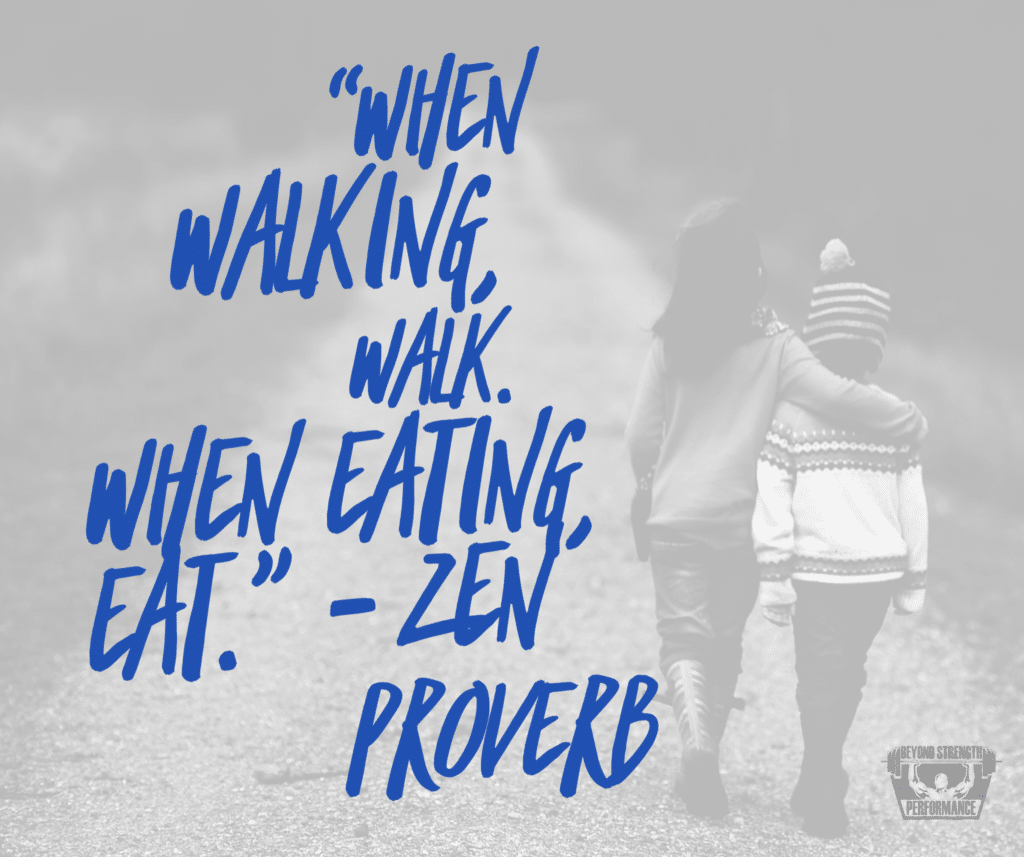We’re currently in the process of writing a transformation guide. This sucker is going to be awesome—and yeah, I’m totally biased—but seriously. It’s going to cover 5 game-changing topics: Mindset, Training, Recovery, Nutrition, and Community. Today’s post provides a preview of a piece from the nutrition section..Enjoy!.– Chris
.
Are we really hungry or are we just eating because we’re bored? As we eat, are we paying attention to what we’re doing, or are we letting ourselves be distracted by the TV and/or work? Actually checking in with how we’re feeling before we eat, while we eat, and after we’ve finished a meal helps us stay on track with hunger cues and eating the amounts we need rather than gorging ourselves unnecessarily.
.
Let’s spend this section getting acquainted with our hunger cues, focusing on mindful eating during a meal, and checking with how we should feel after a meal.
.
Checking in with Hunger Cues
.
There’s a lot of conflicting info out there on meal frequency. Some sources say we have to eat six times per day because that’s how our ancient ancestors grazed their way across the plains of Africa. Others say we need a day of complete fasting to rid our body of the nasty toxins that modern life curses us with. So, what’s the truth? As it goes with most things, hidden somewhere in the sanity between all of the insane claims. This is going to sound crazy, but we should eat when we’re hungry. Despite what the fads and extremists say, the best strategy for meal frequency is checking in with our hunger cues. Let’s get in touch with those suckers.
.
Over the next few days, conduct an experiment on yourself. When you start to feel hungry, sit on that hunger for 20-30 minutes. If you’re still hungry after that time elapsed, good, go on and get yourself something to eat. Not hungry anymore? Well, it would seem that you weren’t truly hungry and were probably responding to some kind of environmental cue, or boredom, telling you that you should eat.
.
Now, let’s focus in a little more on time and how long it takes you to get hungry between meals. If it’s only an hour until you’re hungry again, you probably didn’t eat enough. If it takes somewhere between two to four hours, it’s likely that you ate the right amount of food. If it takes longer than four hours, you probably ate too much.
.
Eating? Good, Just Eat
.
The TV’s on, we’re listening to something, or we’re reading a book—it’s rare that we just sit and eat anymore. That diversion of attention, however, isn’t good for our ability to check in with our satiety and how much food we are eating. Paying attention to multiple things while we eat makes it easier for us to mindlessly shovel more food than we need into our mouths, or go back for seconds that we don’t really need because we didn’t realize we weren’t hungry anymore.
.
Time for another experiment reminiscent of the hunger experiment we just talked about. For the next few days, only eat when you’re eating—for at least one or two meals per day. No TV. No books. No audio. Just you, your food, and the sounds of silence. Pay attention to how you’re feeling while you eat. Pay attention to how much food it takes to make you feel satiated.
.
You’ll be amazed at how much more of your food you’ll actually taste and how much you enjoy the process of eating. Beyond the health and weight benefits of mindful eating, eating is a joy of life, and it’s worth taking the time to pay attention to.
.
When to Stop Eating
.
How do we know when to stop eating? Is it when we’re full? Stuffed? Still hungry? Actually, none of those are the answers. A simple rule that will help you manage your energy balance (keep you from eating too much or too little) is to eat until you’re about eighty percent full. Here’s a fun fact for you, eating until eighty percent full actually comes from a Japanese practice called “hara hachi bu.” Thinking about whether or not we are eighty percent full keeps us checking in with our meal as we eat and helps us decide if we really need any more to eat.
.
We don’t have any hard and fast science for you here, but eating this way has worked for us and for our clients. It keeps us eating mindfully and helps us lean our frames out while maintaining that leanness.
.
Eat Mindfully
.
How hungry are you really? Are you doing anything other than eating? Are you stopping at eighty percent full? These are all great questions to ask internally to keep yourself eating mindfully. And eating mindfully is a great way to have a better experience with your food and keep your body leaner and healthier.

